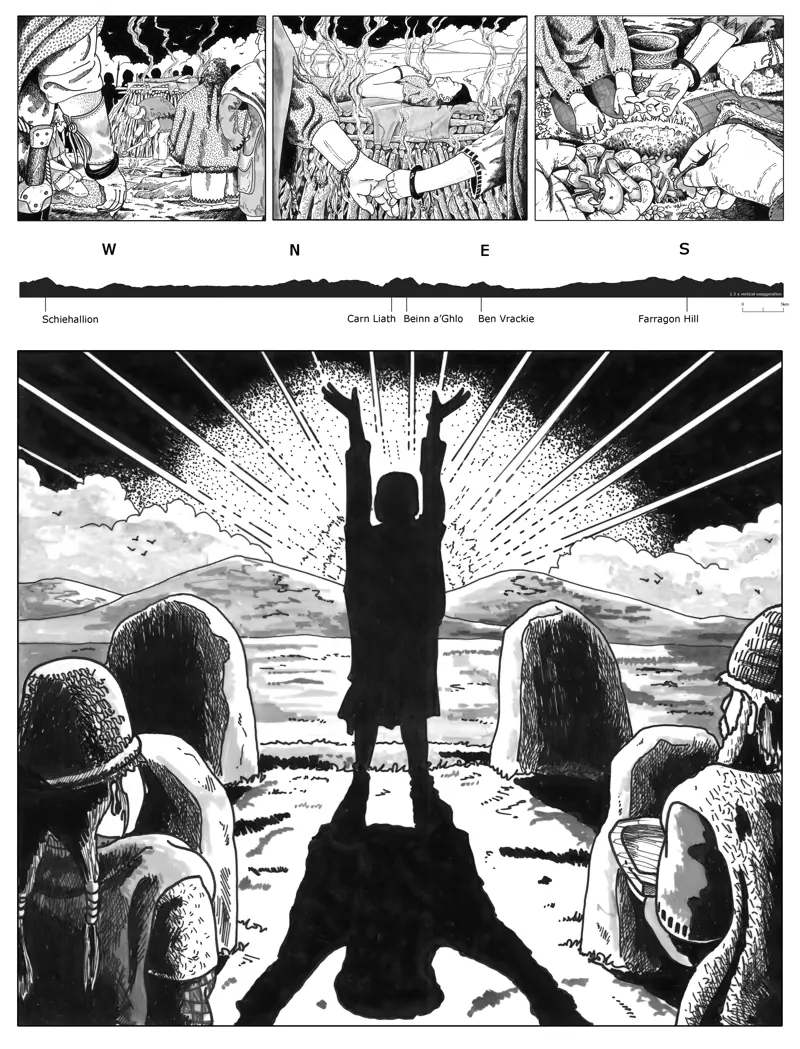Dig deeper: a look at Na Clachan Aoraidh, the Stones of Worship

The stone circle of Na Clachan Aoraidh – the ‘Stones of Worship’ – is set high on the limestone ridge of Cnoc na Craoibhe above Loch Tummel.
Grid reference: NN 8386 6200
The site is an unusual ‘four poster’ stone circle – a square arrangement of four large stones on a low stone-built platform. It was probably built in the Late Bronze Age, about 3000 years ago.
Writing of Na Clachan Aoraidh in 1908, the archaeologist Fred Coles noted that the “site, scenery, megalithic remains and surroundings all combine to render the investigation of this group especially interesting”.
It’s a place with real character. It has spectacular views over the surrounding landscape: towards the mountains of Carn Liath and Beinn a’Ghlo to the north east, Ben Vrackie to the east and towards Schiehallion to the south west. The site also has significant archaeological importance, both in terms of buried archaeological deposits and in structural detail.
Although likely ceremonial, the few excavated examples of ‘four poster’ stone circles often display activities associated with funeral pyres and cremation burials. You’ll find a dense concentration of such sites in northern Perthshire, with examples scattered through the Tay, Earn and Tummel valleys.

This creative storyboard by Alan Braby explores the archaeological evidence: the community gathering to say farewell to their dead; the placing of the woman’s ashes and bone fragments in a shallow pit; and the orientation of the later stone circle towards the summer solstice sun rising over the mountains of Carn Liath and Beinn a’Ghlo in the north-east.
Excavating the site
In 2016, an illegal bonfire was set within the centre of the stone circle, a scheduled monument on Scotland’s national forests and land.
It was unclear from surface observations whether the fire had damaged any archaeological deposits, and we commissioned an excavation to evaluate the impact. Particular care was taken to explore the soil itself, taking samples to look at heat-damaged deposits compared to undamaged areas. The soil was also sieved for microscopic flakes of charcoal and cremated bone.
Through this work, the cremated remains of a woman were found within a hollow in the centre of the site. This woman is thought to have been cremated elsewhere and was perhaps very important within her community. She is likely to have retained this prestige in death. Perhaps people would visit her burial place to commune with her spirit, possibly at certain times of the year.
Following the excavation, the centre of the site was protected under the turf with a layer of gravel. Our archaeologist Matt Ritchie recently checked the site to see how the repair work had bedded in.
Matt explains: “Although the vandalism was unfortunate, by looking to repair and protect the site we have also enabled both conservation and research. After detailed post-excavation analysis in the laboratory, we are now able to tell the story of Na Clachan Aoraidh – of its Bronze Age builders and of the woman who was buried there. This is why we protect these places.”
The long walk up to Na Clachan Aoraidh from Queen's View is certainly worth the effort.
The excavation has been published in the Tayside and Fife Archaeological Journal. You can read the full paper below.
The excavation of Na Clachan Aoraidh (PDF)
- Aspen at Glenmore
- Fungi foragers urged to pick only what they need
- Creating habitats to save rare bee